Xinrui Li
MegaSR: Mining Customized Semantics and Expressive Guidance for Image Super-Resolution
Mar 11, 2025Abstract:Pioneering text-to-image (T2I) diffusion models have ushered in a new era of real-world image super-resolution (Real-ISR), significantly enhancing the visual perception of reconstructed images. However, existing methods typically integrate uniform abstract textual semantics across all blocks, overlooking the distinct semantic requirements at different depths and the fine-grained, concrete semantics inherently present in the images themselves. Moreover, relying solely on a single type of guidance further disrupts the consistency of reconstruction. To address these issues, we propose MegaSR, a novel framework that mines customized block-wise semantics and expressive guidance for diffusion-based ISR. Compared to uniform textual semantics, MegaSR enables flexible adaptation to multi-granularity semantic awareness by dynamically incorporating image attributes at each block. Furthermore, we experimentally identify HED edge maps, depth maps, and segmentation maps as the most expressive guidance, and propose a multi-stage aggregation strategy to modulate them into the T2I models. Extensive experiments demonstrate the superiority of MegaSR in terms of semantic richness and structural consistency.
Integrated Localization and Communication with Sparse MIMO: Will Virtual Array Technology also Benefit Wireless Communication?
Feb 25, 2025Abstract:For the 6G wireless networks, achieving high-performance integrated localization and communication (ILAC) is critical to unlock the full potential of wireless networks. To simultaneously enhance localization and communication performance cost-effectively, this paper proposes sparse multiple-input multiple-output (MIMO) based ILAC with nested and co-prime sparse arrays deployed at the base station. Sparse MIMO relaxes the traditional half-wavelength antenna spacing constraint to enlarge the antenna aperture, thus enhancing localization degrees of freedom and providing finer spatial resolution. However, it also leads to undesired grating lobes, which may cause severe inter-user interference for communication and angular ambiguity for localization. While the latter issue can be effectively addressed by the virtual array technology, by forming sum or difference co-arrays via signal (conjugate) correlation among array elements, it is unclear whether the similar virtual array technology also benefits wireless communications for ILAC systems. In this paper, we first reveal that the answer to the above question is negative, by showing that forming virtual arrays for wireless communication will cause destruction of phase information, degradation of signal-to-noise ratio and aggravation of multi-user interference. Therefore, we propose the hybrid processing for sparse MIMO based ILAC, i.e., physical array based communication while virtual array based localization. To this end, we characterize the beam pattern of sparse arrays by three metrics, demonstrating that despite of the introduction of grating lobes, sparse arrays can also bring benefits to communications thanks to its narrower main lobe beam width than the conventional compact arrays. Extensive simulation results are presented to demonstrate the performance gains of sparse MIMO based ILAC over that based on the conventional compact MIMO.
Movable Antenna for Wireless Communications:Prototyping and Experimental Results
Aug 16, 2024Abstract:Movable antenna (MA), which can flexibly change the position of antenna in three-dimensional (3D) continuous space, is an emerging technology for achieving full spatial performance gains. In this paper, a prototype of MA communication system with ultra-accurate movement control is presented to verify the performance gain of MA in practical environments. The prototype utilizes the feedback control to ensure that each power measurement is performed after the MA moves to a designated position. The system operates at 3.5 GHz or 27.5 GHz, where the MA moves along a one-dimensional horizontal line with a step size of 0.01{\lambda} and in a two-dimensional square region with a step size of 0.05{\lambda}, respectively, with {\lambda} denoting the signal wavelength. The scenario with mixed line-of-sight (LoS) and non-LoS (NLoS) links is considered. Extensive experimental results are obtained with the designed prototype and compared with the simulation results, which validate the great potential of MA technology in improving wireless communication performance. For example, the maximum variation of measured power reaches over 40 dB and 23 dB at 3.5 GHz and 27.5 GHz, respectively, thanks to the flexible antenna movement. In addition, experimental results indicate that the power gain of MA system relies on the estimated path state information (PSI), including the number of paths, their delays, elevation and azimuth angles of arrival (AoAs), as well as the power ratio of each path.
Sparse MIMO for ISAC: New Opportunities and Challenges
Jun 18, 2024



Abstract:Multiple-input multiple-output (MIMO) has been a key technology of wireless communications for decades. A typical MIMO system employs antenna arrays with the inter-antenna spacing being half of the signal wavelength, which we term as compact MIMO. Looking forward towards the future sixth-generation (6G) mobile communication networks, MIMO system will achieve even finer spatial resolution to not only enhance the spectral efficiency of wireless communications, but also enable more accurate wireless sensing. To this end, by removing the restriction of half-wavelength antenna spacing, sparse MIMO has been proposed as a new architecture that is able to significantly enlarge the array aperture as compared to conventional compact MIMO with the same number of array elements. In addition, sparse MIMO leads to a new form of virtual MIMO systems for sensing with their virtual apertures considerably larger than physical apertures. As sparse MIMO is expected to be a viable technology for 6G, we provide in this article a comprehensive overview of it, especially focusing on its appealing advantages for integrated sensing and communication (ISAC) towards 6G. Specifically, assorted sparse MIMO architectures are first introduced, followed by their new benefits as well as challenges. We then discuss the main design issues of sparse MIMO, including beam pattern synthesis, signal processing, grating lobe suppression, beam codebook design, and array geometry optimization. Last, we provide numerical results to evaluate the performance of sparse MIMO for ISAC and point out promising directions for future research.
DeepGI: An Automated Approach for Gastrointestinal Tract Segmentation in MRI Scans
Jan 27, 2024Abstract:Gastrointestinal (GI) tract cancers pose a global health challenge, demanding precise radiotherapy planning for optimal treatment outcomes. This paper introduces a cutting-edge approach to automate the segmentation of GI tract regions in magnetic resonance imaging (MRI) scans. Leveraging advanced deep learning architectures, the proposed model integrates Inception-V4 for initial classification, UNet++ with a VGG19 encoder for 2.5D data, and Edge UNet for grayscale data segmentation. Meticulous data preprocessing, including innovative 2.5D processing, is employed to enhance adaptability, robustness, and accuracy. This work addresses the manual and time-consuming segmentation process in current radiotherapy planning, presenting a unified model that captures intricate anatomical details. The integration of diverse architectures, each specializing in unique aspects of the segmentation task, signifies a novel and comprehensive solution. This model emerges as an efficient and accurate tool for clinicians, marking a significant advancement in the field of GI tract image segmentation for radiotherapy planning.
Linear Relative Pose Estimation Founded on Pose-only Imaging Geometry
Jan 24, 2024Abstract:How to efficiently and accurately handle image matching outliers is a critical issue in two-view relative estimation. The prevailing RANSAC method necessitates that the minimal point pairs be inliers. This paper introduces a linear relative pose estimation algorithm for n $( n \geq 6$) point pairs, which is founded on the recent pose-only imaging geometry to filter out outliers by proper reweighting. The proposed algorithm is able to handle planar degenerate scenes, and enhance robustness and accuracy in the presence of a substantial ratio of outliers. Specifically, we embed the linear global translation (LiGT) constraint into the strategies of iteratively reweighted least-squares (IRLS) and RANSAC so as to realize robust outlier removal. Simulations and real tests of the Strecha dataset show that the proposed algorithm achieves relative rotation accuracy improvement of 2 $\sim$ 10 times in face of as large as 80% outliers.
Multi-User Modular XL-MIMO Communications: Near-Field Beam Focusing Pattern and User Grouping
Aug 23, 2023

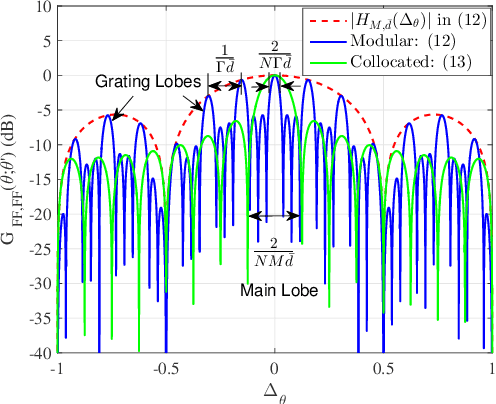

Abstract:In this paper, we investigate multi-user modular extremely large-scale multiple-input multiple-output (XL-MIMO) communication systems, where modular extremely large-scale uniform linear array (XL-ULA) is deployed at the base station (BS) to serve multiple single-antenna users. By exploiting the unique modular array architecture and considering the potential near-field propagation, we develop sub-array based uniform spherical wave (USW) models for distinct versus common angles of arrival/departure (AoAs/AoDs) with respect to different sub-arrays/modules, respectively. Under such USW models, we analyze the beam focusing patterns at the near-field observation location by using near-field beamforming. The analysis reveals that compared to the conventional XL-MIMO with collocated antenna elements, modular XL-MIMO can provide better spatial resolution by benefiting from its larger array aperture. However, it also incurs undesired grating lobes due to the large inter-module separation. Moreover, it is found that for multi-user modular XL-MIMO communications, the achievable signal-to-interference-plus-noise ratio (SINR) for users may be degraded by the grating lobes of the beam focusing pattern. To address this issue, an efficient user grouping method is proposed for multi-user transmission scheduling, so that users located within the grating lobes of each other are not allocated to the same time-frequency resource block (RB) for their communications. Numerical results are presented to verify the effectiveness of the proposed user grouping method, as well as the superior performance of modular XL-MIMO over its collocated counterpart with densely distributed users.
Near-Field Beam Focusing Pattern and Grating Lobe Characterization for Modular XL-Array
May 09, 2023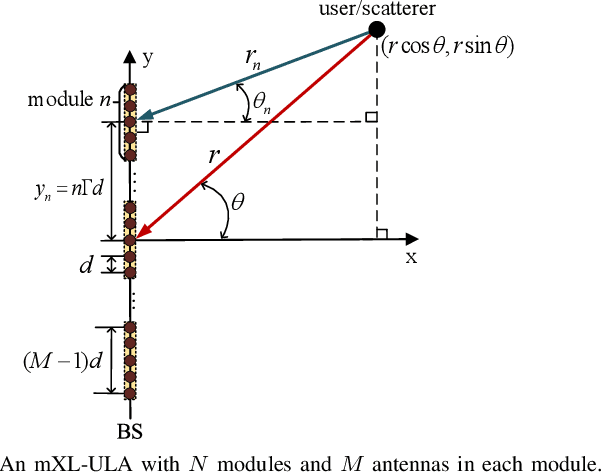
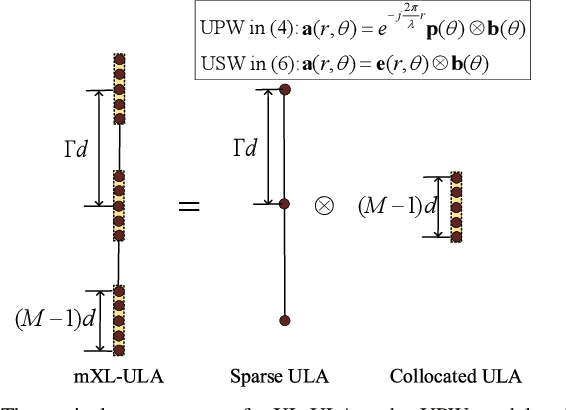
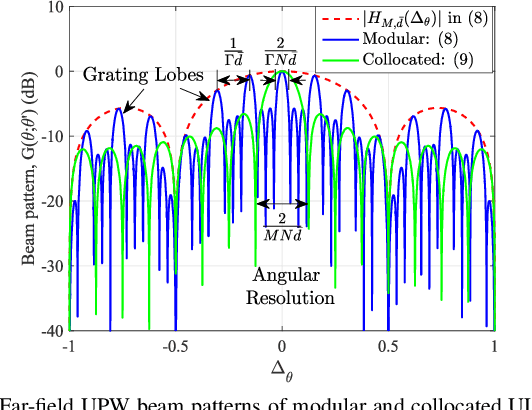
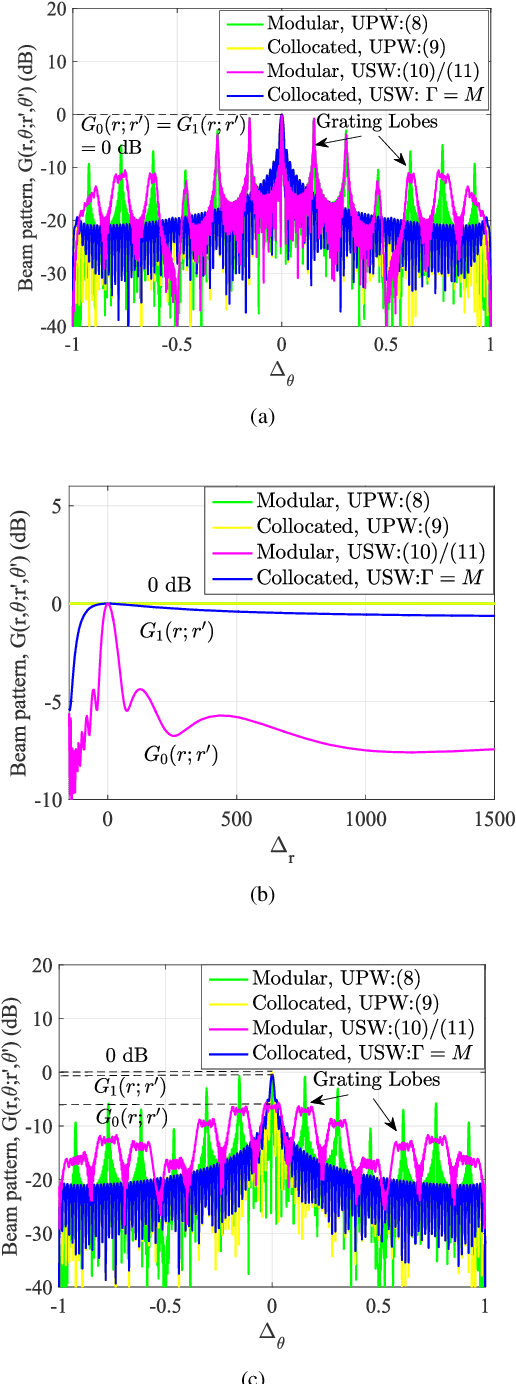
Abstract:In this paper, we investigate the near-field modelling and analyze the beam focusing pattern for modular extremely large-scale array (XL-array) communications. As modular XL-array is physically and electrically large in general, the accurate characterization of amplitude and phase variations across its array elements requires the non-uniform spherical wave (NUSW) model, which, however, is difficult for performance analysis and optimization. To address this issue, we first present two ways to simplify the NUSW model by exploiting the unique regular structure of modular XL-array, termed sub-array based uniform spherical wave (USW) models with different or common angles, respectively. Based on the developed models, the near-field beam focusing patterns of XL-array communications are derived. It is revealed that compared to the existing collocated XL-array with the same number of array elements, modular XL-array can significantly enhance the spatial resolution, but at the cost of generating undesired grating lobes. Fortunately, different from the conventional far-field uniform plane wave (UPW) model, the near-field USW model for modular XL-array exhibits a higher grating lobe suppression capability, thanks to the non-linear phase variations across the array elements. Finally, simulation results are provided to verify the near-field beam focusing pattern and grating lobe characteristics of modular XL-array.
Essential Number of Principal Components and Nearly Training-Free Model for Spectral Analysis
Dec 30, 2022



Abstract:Through a study of multi-gas mixture datasets, we show that in multi-component spectral analysis, the number of functional or non-functional principal components required to retain the essential information is the same as the number of independent constituents in the mixture set. Due to the mutual in-dependency among different gas molecules, near one-to-one projection from the principal component to the mixture constituent can be established, leading to a significant simplification of spectral quantification. Further, with the knowledge of the molar extinction coefficients of each constituent, a complete principal component set can be extracted from the coefficients directly, and few to none training samples are required for the learning model. Compared to other approaches, the proposed methods provide fast and accurate spectral quantification solutions with a small memory size needed.
Image Retargetability
Feb 12, 2018
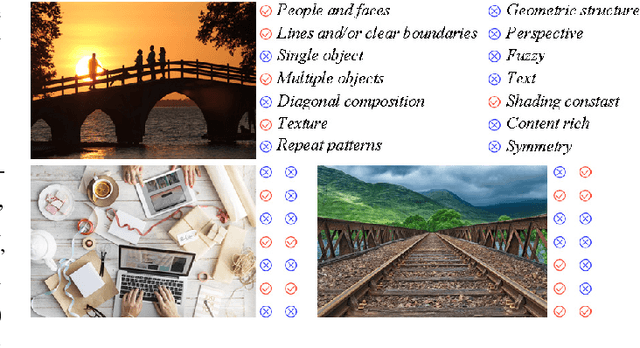


Abstract:Real-world applications could benefit from the ability to automatically retarget an image to different aspect ratios and resolutions, while preserving its visually and semantically important content. However, not all images can be equally well processed that way. In this work, we introduce the notion of image retargetability to describe how well a particular image can be handled by content-aware image retargeting. We propose to learn a deep convolutional neural network to rank photo retargetability in which the relative ranking of photo retargetability is directly modeled in the loss function. Our model incorporates joint learning of meaningful photographic attributes and image content information which can help regularize the complicated retargetability rating problem. To train and analyze this model, we have collected a database which contains retargetability scores and meaningful image attributes assigned by six expert raters. Experiments demonstrate that our unified model can generate retargetability rankings that are highly consistent with human labels. To further validate our model, we show applications of image retargetability in retargeting method selection, retargeting method assessment and photo collage generation.
 Add to Chrome
Add to Chrome Add to Firefox
Add to Firefox Add to Edge
Add to Edge